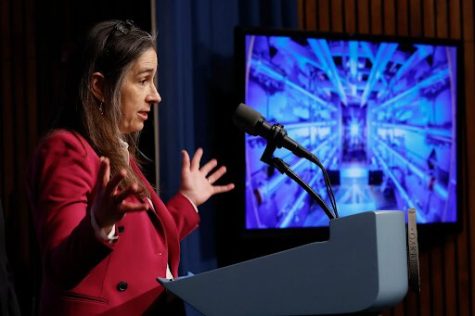What the Nuclear Fusion Breakthrough Could Mean for the Future

A technician is seen inside the preamplifier support structure of the National Ignition Facility at the Lawrence Livermore National Laboratory in California. (CNN)
On December 5, the U.S. Department of Energy announced that scientists at the Lawrence Livermore National Laboratory’s National Ignition Facility in California had a breakthrough with nuclear fusion, an energy source that produced more energy from fusion than they used to conduct the experiment, reported Ella Nilsen of CNN. This is potentially world changing technology, as nuclear fusion as a source of energy production would be safe and sustainable, as well as tackle climate change currently and for generations to come.
“Simply put, this is one of the most impressive scientific feats of the 21st century,” said Jennifer Granholm, U.S. energy secretary, at a press conference (CBS News).
To put this into context, energy is produced in a variety of ways: solar, hydroelectric, wind, nuclear, etc. In terms of nuclear energy, societies currently use nuclear fission, a method where the nucleus of an atom splits into multiple nuclei and produces energy. This method of energy production is likely the cleanest form of energy, as it produces almost no carbon, making it a necessity for combatting the effects of climate change as a result of fossil fuels and carbon emissions, as expressed by Andrea Galindo, writer for the International Atomic Energy Agency (IAEA) Office of Public Information and Communication.
However, nuclear fission emits radioactivity, which can be extremely dangerous for humans if they are in close contact with high amounts.
One of the worst disasters as a result of nuclear fission was the Chernobyl accident in 1986. According to the World Nuclear Organization, in Chernobyl, Ukraine, the nuclear power plant’s reactor was destroyed due to a flawed design and operator errors, which killed multiple workers instantly, as well as others who were on site after the accident from acute radiation syndrome (ARS). Civilian cancer diagnoses after the accident were likely due to radioactive iodine fallout as well.
Because of these potential issues, scientists have been working towards nuclear fusion, which is a replication of how the sun gains its energy, where the nuclei of atoms fuse together. According to communication officer at the IAEA, Irena Chatzis, this method, as opposed to nuclear fission, would likely be the best form of energy creation, as it would not contribute to the pollution of greenhouse gasses and would not produce dangerous radioactive waste.
However, up until now, it has been up in the air if nuclear fusion would even be possible on Earth. Chatzis went on to detail the reasons for these speculations.
“On earth, we need temperatures exceeding 100 million degrees Celsius and intense pressure to make deuterium and tritium fuse, and sufficient confinement to hold the plasma and maintain the fusion reaction long enough for a net power gain, i.e. the ratio of the fusion power produced to the power used to heat the plasma,” said Chatzis.
Originally, as explained by The Guardian, the Californian National Ignition Facility was created to perform small experiments that would simulate the reaction of a nuclear bomb, so the U.S. could retain its nuclear weapons without having to test them. However, these experiments also allowed them to move closer to achieving nuclear fusion.
Despite this seemingly impossible technology, recently, scientists, along with 192 lasers that projected 2.05 megajoules of energy, were able to produce 3 megajoules of nuclear fusion, which was an energy gain of 1.5, reported Kenneth Chang of The New York Times.
CNN also stated that there is still a long way to go until nuclear fusion becomes a widespread practice and a part of America’s electric grid, as this event only produced enough energy to boil 2.5 gallons of water. But, experts believe that this is still an incredible feat that will be extremely beneficial in the long-term.

“I think it’s moving into the foreground and probably with concerted effort and investment, a few decades of research on the underlying technologies could put us in a position to build a power plant,” said Lawrence Livermore National Laboratory Director Kim Budil.
Overall, this scientific discovery may not seem like much, but in the long-term it offers society a promising future that will benefit humans and animals, and it will ultimately keep the Earth a safe and habitable place. As scientists continue to progress beyond this success, Americans and the world alike should feel very optimistic about the potential of nuclear fusion.






